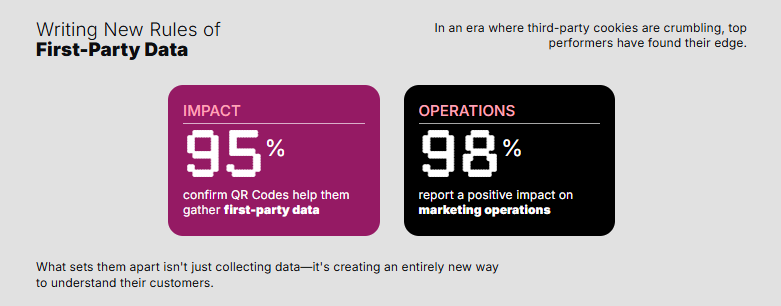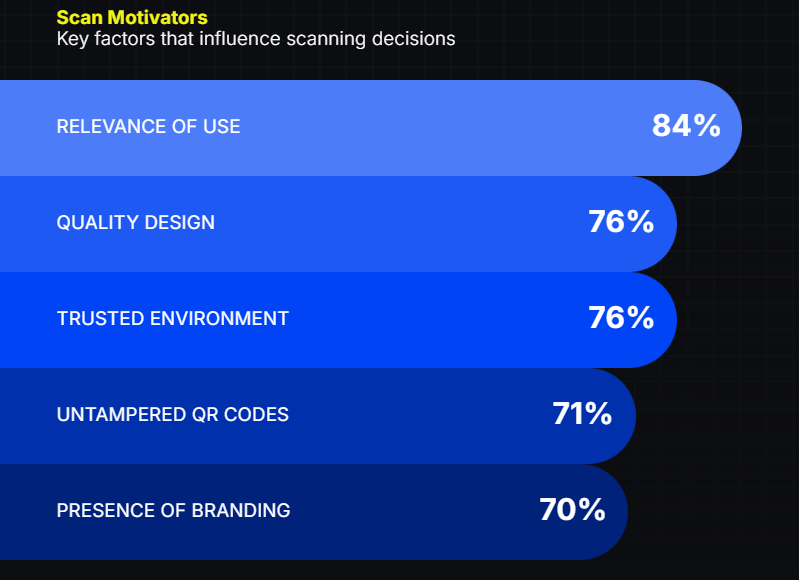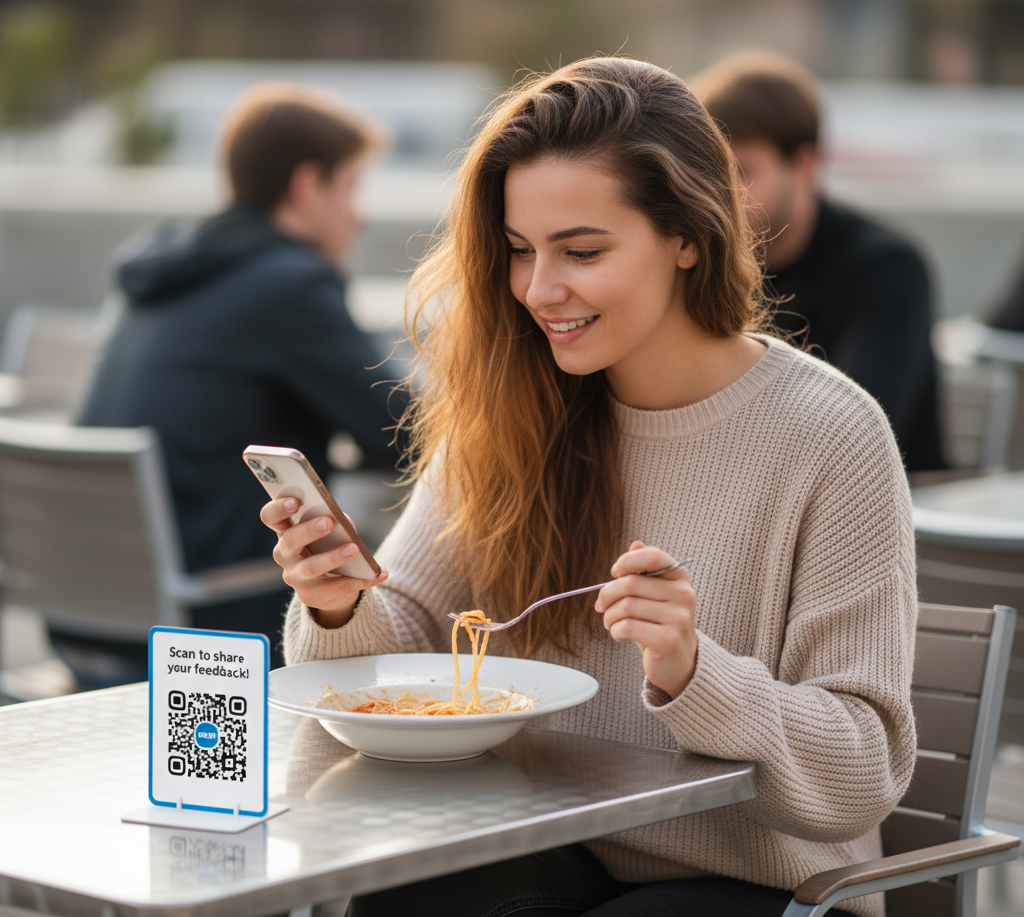QR Codes: The Ultimate CTA for First-Party Data

A QR Code scan is like a raised hand in a crowded room. It's voluntary, visible, and tells you exactly who's interested. Compare that to website cookies, which are more like secretly following someone around a store.
As privacy laws crack down on digital surveillance, savvy marketers are realizing something obvious: permission beats stalking every time. The data you earn will always outperform the data you take.
That deliberate scan gives you context and not just contact information. You know exactly where they were, what caught their attention, and that they chose to engage. It's intent wrapped in action.
This move from surveillance to permission marketing isn't just about compliance. It's about building relationships instead of collecting profiles. Every scan represents a micro-moment of trust, and for marketers who understand this, QR Codes have become the ultimate call to action.
Why the focus on first-party data now?
Marketing is undergoing a reset. Third-party tracking is losing credibility, privacy laws are tightening, and consumers are asking for transparency and control.
With the old tools of silent surveillance fading out, the question has shifted from how much data a brand can gather to how responsibly it can do so. Clean, contextual, and consent-based data has become the new competitive edge.

That’s where QR Codes come in. Each scan is a choice, making QR Code data not only compliant but also more reliable and meaningful than any third-party cookie.
Why scans speak louder than clicks
Clicks are cheap. Scans aren’t.
A click can come from anywhere: a wrong screen tap, a bot, or an algorithmic push. A scan, on the other hand, takes effort. Someone has to notice a QR Code, lift their phone, point their camera, wait for recognition, and tap to follow through.
Unlike clicks, scans carry context. Where did it happen? On packaging, in-store signage, or an ad? Each scan connects digital behavior to a real-world moment, helping brands understand what drives action, not just where traffic comes from.
And this behavior has become mainstream. According to the 2025 State of QR Codes Report, 59% of customers scan QR Codes daily, and 9 in 10 users do so weekly.

Each scan also filters for relevance. 84% of users are more likely to scan when the use is clearly relevant, and 76% consider the trustworthiness of the environment. Scans don’t measure reach; they measure genuine interest. That’s where the data journey begins.
How QR Code data becomes actionable insight
The difference between smart brands and everyone else isn't the data they collect—it's what they do with it.
Raw numbers: The proof of action
Every scan is a timestamp of intent. It confirms that someone saw value and took action. But raw data is just numbers. It tells you that something happened, not why. Most brands stop here, counting scans like website hits, and they miss the bigger picture.
Context: What the numbers mean
Context gives that data meaning. It tells you where a scan happened, when it occurred, and how it was triggered. Was it at a store display on a Sunday afternoon or on packaging during dinner prep? These details turn anonymous actions into moments you can understand. With context, numbers become behavior.
Patterns: When behavior repeats
Patterns emerge from repetition. You begin to see that most scans happen after 6 PM or that packaging drives more engagement than in-store signage. This is where intuition meets evidence.
Strategy: Decisions that drive results
Strategy is where the loop closes. It’s when data and patterns translate into smarter decisions, like changing QR Code placements, optimizing offers, or refining experiences.
Brands that reach this stage stop chasing engagement and start designing for it. With QR Codes, insights compound quickly because every new scan refines what you already know.
QR Codes turn passive observation into active insight, helping marketers move from assumptions to evidence, from reaction to strategy. This clarity drives confident, data-informed decisions.
How brands can use QR Codes to collect first-party data
The real opportunity lies in using QR Codes to collect permission-based data that deepens understanding without crossing privacy lines. Here’s how brands can do that responsibly.
1. Turn engagement moments into data exchanges
A scan is the start of a conversation, but it only becomes data when there’s clear value on the other side. Instead of sending people to your homepage, offer something worth exchanging information for.
That might be:
- A discount or exclusive offer in return for an email
- Early access to new launches in exchange for preferences
- A downloadable guide or insider report gated behind a short sign-up
- A personalized quiz that captures product or style preferences
For example: “Scan to get 20% off and unlock your next best-fit quiz” or “Scan to join our cooking community and receive recipe drops.

The scan gets the attention; the value exchanges earn consent.
2. Use scans to trigger progressive data capture
Data collection doesn’t need to happen all at once. The most effective brands use progressive profiling, collecting small pieces of information across multiple interactions.
For example:
- First scan → email opt-in for a discount
- Second scan → quick preference quiz (“What are you shopping for today?”)
- Third scan → feedback or satisfaction survey
Each micro-interaction builds a richer profile, earned over time through transparency and value.
3. Build contextual intelligence automatically
Not all first-party data has to be entered manually. Every QR Code scan carries built-in contextual signals (location, device type, and time of interaction) that reveal how and where engagement happens.
For example:
- A beverage brand sees most scans happen during weekend evenings → adjusts campaign timing
- A retail chain finds certain in-store displays outperform others → reallocates spend accordingly
These behavioral patterns, combined with any declared data, help brands understand intent without invading privacy.
4. Create feedback and survey loops post-purchase
QR Codes are an effortless way to collect direct customer feedback right after a transaction or experience.
Use on-pack or receipt QR Codes that say: “Tell us what you think in 30 seconds” or “Rate your meal to unlock a free add-on next time.”

This turns casual feedback into structured first-party data—satisfaction score, product preferences, and sentiment—all volunteered in context.
5. Tie QR Code scans to identity through optional sign-ins
To go beyond anonymous scans, encourage users to identify themselves voluntarily.
Integrate QR Codes with account creation or loyalty programs:
- “Scan to sign in and track your orders.”
- “Scan to add this to your rewards wallet.”
Each login links scan data to a real customer profile, helping brands connect offline engagement to digital identity securely and with consent.
6. Incentivize ongoing participation through gamification
Gamified QR Code experiences keep customers engaged while encouraging data sharing.
For example:
- Spin-the-wheel or scratch-and-win campaigns that require basic information entry
- Leaderboard contests that reward repeat scans
- Collect-to-win scavenger hunts for retail or events
Every game mechanic doubles as a data touchpoint that is fun, voluntary, and value-based.
7. Personalize content delivery in real time
Dynamic QR Codes can adapt the experience based on what’s known about a user or context.
For example:
- A first-time scanner sees a welcome message and sign-up prompt
- A returning customer gets a personalized offer or survey
This kind of adaptive flow not only improves engagement but also strengthens the quality and accuracy of the data being collected.
8. Close the loop with CRM and analytics integration
All this collected data is only powerful when it’s unified.
Integrating QR Code scan data with CRM or analytics tools allows you to:
- Tag new leads automatically
- Attribute offline interactions to specific campaigns
- Identify repeat scanner and segment audiences by behavior
The outcome isn’t just data collection, it’s insight generation tied directly to measurable business outcomes.
As QR Code technology matures, first-party data collection is no longer about volume. It’s about designing systems where every scan earns consent, every interaction adds context, and every piece of data deepens trust.
The CTA that outlasts campaigns
Most marketing data today is built on borrowed attention—cookies, pixels, and automated clicks that mean little. QR Code data is built on intent, making it more reliable, contextual, and infinitely more valuable.
While others are stuck cleaning up bad data or chasing anonymous traffic, brands using QR Codes already know who’s interested, when they act, and why. That clarity turns engagement into intelligence and interactions into measurable growth.
The brands leading the next decade won’t just collect data, they’ll earn it. And for marketers who understand that difference, QR Codes aren’t just the next big thing. They’re the most trusted source of first-party data you can build on.
